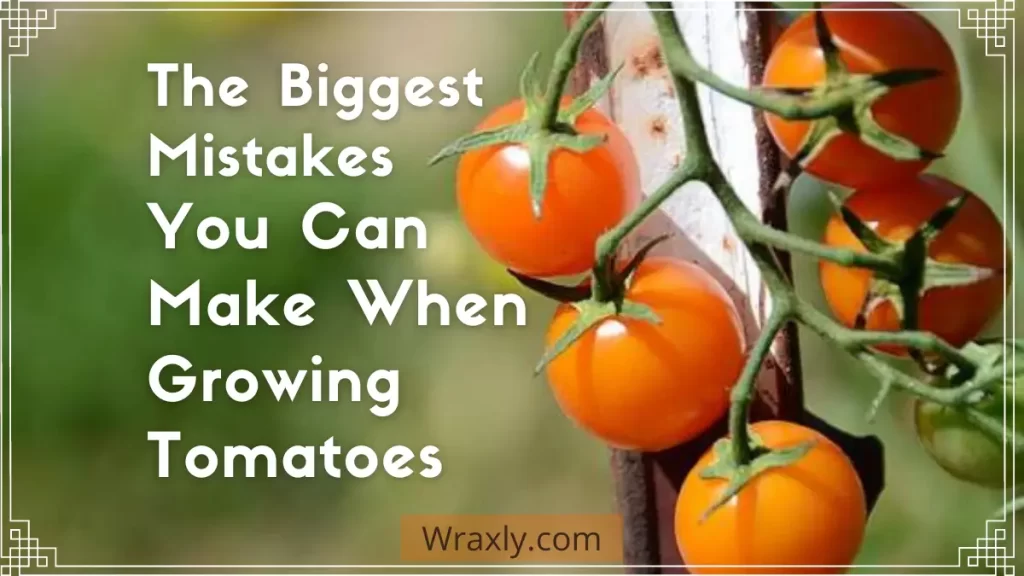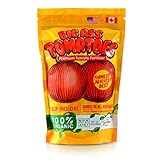Tomatoes are one of the most popular edible plants that hobbyist gardeners grow. But while this plant is generally easy to grow, there are some mistakes you can make when growing tomatoes.

The 9 Biggest Tomato Growing Mistakes
There are a few common pitfalls you can make while growing tomatoes. Here are nine mistakes to avoid:
- Poor Planting
- Crowded Spacing
- Incorrect Soil Nutrients
- Improper Watering
- Lack of Staking
- Bad Pruning
- Inadequate Containers
- Incompatible Companion Plants
- Forgetting Mulch
Below, you can learn how each of those mistakes can be detrimental to your tomato crop. After we cover those, we’ll answer a few other questions gardeners ask about growing tomato plants.
Poor Planting
At times, gardeners get their tomato-growing wrong from the onset. If you don’t know how to plant a tomato properly, you can’t expect to meet success. When growing tomatoes, you must plant them in the correct place and at the ideal time.
Planting Tomatoes in the Wrong Place
The best location for a tomato plant is one that receives direct sunlight for the entire day. Tomato plants that get less than six hours of light per day produce smaller yields and have weaker growth habits. The same is true if you choose to plant your tomato plants in nutrient-deficient soil.
Planting Tomatoes at the Wrong Time
Most tomato plants need 50 to 100 days of warm weather to mature into a fruit-producing plant. Planting too early risks exposing your plant to frost, which will likely kill it. By contrast, if you plant too late, there won’t be enough time left in the season for your plant to develop. Late spring is usually the best time to plant.
Crowded Spacing
When you plant multiple tomato plants too close together, they will begin to compete for sunlight and nutrients. Dense planting also increases the odds of disease. Overlapping leaves prevent moisture from evaporating properly. Give each of your tomato plants about two feet of space for the best results.
Incorrect Soil Nutrients
Don’t allow your tomato plant to grow in soil that lacks nutrients. You can add compost and similar materials to ensure that’s not the case. You can also fertilize twice per month until your plant begins to produce fruit. However, excessive amounts of nitrogen can encourage your plant to allocate its energy towards growing foliage rather than fruit.
Aim to give your tomato plant a balanced fertilizer or one that is higher in phosphorus and potassium. Tomato plants also enjoy receiving other supplemental nutrients like calcium and magnesium. Without a proper blend of nutrients supplied at the right time, you may notice disease and defects in your tomatoes.
Recommended Tomato Plant Fertilizers
| Image | Title | Prime | Buy |
|---|---|---|---|
 Top
Top | Tomato-tone Organic Fertilizer - FOR ALL YOUR TOMATOES, 4 lb. bag | PrimeEligible | Check Price on Amazon |
Top Top
Top | Dr. Earth Organic 5 Tomato, Vegetable & Herb Fertilizer Poly Bag | PrimeEligible | Check Price on Amazon |
 Top
Top | Neptune's Harvest Tomato & Veg Fertilizer 2-4-2, 36 oz | PrimeEligible | Check Price on Amazon |
 Top
Top | Ludicrous Nutrients Big Ass Tomatoes Premium Gardening Fertilizer Nutrients Indoor or Outdoor Works with All Vegetables, Plants (1.5 lbs) | PrimeEligible | Check Price on Amazon |
 Top
Top | Espoma Tomato! Liquid Plant Food, Natural & Organic Tomato & Vegetable Food, 18 fl oz, Pack of 2 | PrimeEligible | Check Price on Amazon |
 Top
Top | Tomato Fertilizer by EZ-gro is a High Potassium Fertilizer for Your Tomato Plants | Field Tested Tomato Plant Food for Vegetables | A Concentrated Liquid Tomato Plant Fertilizer | 1 Quart | PrimeEligible | Check Price on Amazon |
Improper Watering
There are a few mistakes you can make while watering a tomato plant. Here are a few of the most widespread tomato watering errors gardeners make:
- Too much water: When your tomato plant receives too much water, it will wilt and become discolored.
- Overhead watering: Watering your tomato plant from above leaves too much moisture on the leaves, which can lead to disease.
- Inconsistent watering: Tomato plants enjoy consistent watering. By default, you should give your tomato plant water at the same time of the week.
While those watering mistakes are prevalent, you can’t circumvent them by not watering altogether. Tomato plants still need plenty of water each week to thrive.
Recommended Tomato Watering Systems
| Image | Title | Prime | Buy |
|---|---|---|---|
 | Flantor Garden Irrigation System, 1/4" Tubing Watering Drip Kit Automatic Irrigation Equipment Set | PrimeEligible | Check Price on Amazon |
Top | Rain Bird SWDMSPKIT Drip Irrigation Spot Watering Manifold on a Spike Kit, Bubblers and Emitters | PrimeEligible | Check Price on Amazon |
 | Automatic Watering System with 30-Day Watering Cycle Timer | PrimeEligible | Check Price on Amazon |
 | Orbit 57946 B-hyve Smart 6-Zone Indoor/Outdoor Sprinkler Controller, Compatible with Alexa, 6 Station | PrimeEligible | Check Price on Amazon |
 | Raindrip R560DP Automatic Watering Kit for Container and Hanging Baskets, Water up to 20 plants with this kit , Black | PrimeEligible | Check Price on Amazon |
Lack of Staking
The structure of a tomato plant is not all that strong. As such, you’ll need to support your tomato plants with stakes or with a cage. Tomato plants that grow without the support of a physical structure are prone to falling over. Once a tomato plant falls over, its fruit can spoil or become food for slugs in your garden soil.
Recommended Tomato Plant Cages
| Image | Title | Prime | Buy |
|---|---|---|---|
Top | Esbaybulbs Plant Support Cages Tomatos Stake 1.2m Multi-fuction Garden Trellis for Climbing Plants, Vines, Flower, Vegetables and Potted Plants 2 Pack | PrimeEligible | Check Price on Amazon |
 | 4 Pack Garden Plant Support Tomato Cage, Upgrade 24" Trellis for Climbing Plants, Plant Trellis Kits with 4 Self Watering Spikes and 20 Plant Clips (24") | PrimeEligible | Check Price on Amazon |
 | Hydrofarm GCTR 10 Gal Tomato Garden Planting Grow System with 4 Foot Trellis Wheels for Indoor/Outdoor Climbing Vines & Flowers Tree Tower, Green | PrimeEligible | Check Price on Amazon |
 | Tomato Cages for Garden, 2 Packs 48" Plant Support Tomato Trellis for Climbing Plants Outdoor Indoor & Pots with 18Pcs Retractable Steel Core Plant Stakes, 6 Shape-adjustable Rings | PrimeEligible | Check Price on Amazon |
Bad Pruning Habits
Allowing suckers and low-growing stems to remain on your tomato plant is another opportunity for your plant to contract moisture and disease from the ground. Likewise, the pruning tools you use should be sterile as another way to keep your plant safe from infection.
Some gardeners also make the mistake of pruning their tomato plants too early. In most scenarios, you should wait until your tomato plant is about one to one and a half feet tall. By that time, it will be mature enough to respond to your pruning cuts with new growth.
Recommended Pruning Sheers
| Image | Title | Prime | Buy |
|---|---|---|---|
 Top
Top
Top
Top | EnduroPRO Titanium Pruning Shears - Ergonomic Gardening Tool for Effortless Cuts | PrimeEligible | Check Price on Amazon |
Top | KAKURI Japanese Pruning Shears for Gardening Heavy Duty, Made in JAPAN, 8 Inch High Quality Forged Japanese Carbon Steel, Professional Garden Pruners with Leather Sheath, Silver Black | PrimeEligible | Check Price on Amazon |
 Top
Top
Top
Top | Mueller Soft Grip Garden Pruning Shears, Durable Hardened Titanium Blades, 1.2" Cutting Diameter, Blade Lock | PrimeEligible | Check Price on Amazon |
 | Fiskars Pruning Shears, Sharp Precision-ground Steel Blade, 5.5” Plant Clippers | PrimeEligible | Check Price on Amazon |
 | Mr. Pen- Pruning Shears, 8" Professional | PrimeEligible | Check Price on Amazon |
 | Gonicc 8" Professional Pruning Shears | PrimeEligible | Check Price on Amazon |
 | Red Pruning Shears,Titanium Alloy High Carbon Steel Manual Grey Garden Shears, 8 Inch | PrimeEligible | Check Price on Amazon |
Inadequate Containers
Tomatoes that grow in containers that are too small or have poor drainage are destined to fail. Pots that lack space will cause your tomato plant to become rootbound. Containers that don’t drain properly lead to root rot.
The best containers are ones that have plenty of space into which your tomato plant can expand its roots. They also allow water to permeate through them, avoiding waterlogging. Fabric grow bags tend to perform best in both those categories compared to other container styles.
Recommended Tomato Growing Containers
| Image | Title | Prime | Buy |
|---|---|---|---|
 Top
Top | Outland Living Large Tomato Planter with Metal Trellis 68 Inch, 20 Gallon Fabric Pot with Drainage - Black (Pack of 1) | Prime | Check Price on Amazon |
Top | Wraxly Fabric Grow Bags - 7 Gallon Assorted Colors + Bonus Bag! | PrimeEligible | Check My Price on Amazon |
 Top
Top | Hydrofarm GCTB Tomato Barrel with 4-Foot Tower | Prime | Check Price on Amazon |
 Top
Top | Pri Gardens Upside Down Tomato Planter, 2- Pack | PrimeEligible | Check Price on Amazon |
 Top
Top | 3 Pack Upside Down Planter Tomato Grow Bags Durable with 13 Grow Pouches | PrimeEligible | Check Price on Amazon |
Incompatible Companion Plants
While there are a few companion plants that will aid the growth of your tomato plant, there are some plants that you should never allow to grow nearby. Here are a few popular plants that you should not grow close to a tomato:
- Cabbage
- Cauliflower
- Kale
- Kohlrabi
- Potatoes
The plants in the list above can hinder your tomato plant’s growth and may increase the likelihood of an infestation. Thankfully, there are better options you can grow in your garden beds beside your tomatoes.
What are the Best Companion Plants for Tomatoes?
Although some plants have a negative impact on your tomatoes, others are entirely beneficial. Here are a few of the best companions for tomato plants:
- Basil
- Oregano
- Sweet potatoes
- Garlic
- Coneflowers
There are numerous other plants that will aid your tomato plants, each of which offers unique benefits. While some will help reduce the odds of disease, others support pollination and weed control.
Forgetting Mulch
While mulching is common practice in landscaping, many gardeners neglect this standard planting chore. If you forget to spread a healthy layer of mulch around your tomato plants, you cannot expect to see the best results. Mulch helps to maintain the consistent soil moisture that tomatoes love and helps regulate soil temperature as well.
Several types of mulch work especially well for tomato plants. Organic materials like wood mulch, grass clippings, and straw help add nutrients to the soil that your tomato plants will put to good use.
FURTHER READING
- How Long Does it Take for Cherry Tomatoes to Ripen?
- Growing Tomatoes in Fabric Grow Bags
- Sun Sugar Tomato vs Sungold: Which One is the Better Tomato?
- Plum Tomatoes Demystified
- How to Master Hydroponic Tomatoes
Tomato Growing FAQs
Since we’ve covered some of the most prominent mistakes you can make while growing tomatoes, let’s address a few other questions gardeners have on the topic.
The secret to growing great tomatoes is meeting all their basic requirements for sun exposure, soil nutrients, and soil moisture. It can also help to add Epsom salt and crushed eggshells to your soil when planting your tomato plant. Those amendments help ward off magnesium and calcium deficiencies, respectively.
In their native tropical climate, tomatoes are a perennial plant that can live for multiple years. However, in other parts of the world, tomatoes grow as annual, as they are unable to survive cold winters. In those colder regions, the lifespan of a to
The time it takes your plant to reach an age at which it can produce fruit will vary based on the tomato variety you grow. Most plants take around 70 days to reach that maturity. Once you begin to see tomato fruits forming on your tomato plant, you can expect it to take about another month for them to be ready for harvest.
Regular fertilization is one way to boost the growth rate of your tomato plants. The fertilizer you use should have a balanced mix of nitrogen, phosphorus, and potassium to guarantee your plant gets all the essential nutrients it needs. Soil temperature can also play a role. Warm soils create the ideal setting in which your tomato can grow as fast as possible.
Although fertilizer is generally beneficial to plant growth, too much can be detrimental. When you over fertilizer a tomato plant, it will become extremely long and leggy. The plant may also put forth fewer fruits depending on the type of fertilizer you use.
Determinate and indeterminate tomatoes are two broad groups of popular tomato species. A determinate tomato plant tends to produce ripe fruit at a single point during the season. By contrast, indeterminate tomatoes put forth their fruits over a longer portion of the growing season. Indeterminate tomato plants also tend to be larger, while determinate tomatoes stop growing at a moderate height.
Final Thoughts on the Biggest Mistakes You Can Make When Growing Tomatoes
While there are plenty of mistakes you can make, tomatoes are often easy to grow. But before you set out to grow some in your garden, make sure you review the seven tomato growing mistakes we’ve just outlined above.

John Haryasz is a freelance writer and landscape designer. In the field of landscape architecture, he has contributed to many successful design projects throughout the country. As a writer, John specializes in creating captivating and informative web content. Through that work, he aims to share his design knowledge and promote engagement with the outdoor world.

![How to Water Indoor Plants [Plant Care 101]](https://wraxly.com/wp-content/uploads/2021/03/How-to-Water-Indoor-Plants-Plant-Care-101-1200-1024x576.webp)

![Growing Plants from Cuttings [A Simple Guide]](https://wraxly.com/wp-content/uploads/2021/03/Growing-Plants-from-Cuttings-A-Simple-Guide-1200-1024x576.webp)